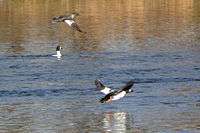Common goldeneye
| Common goldeneye | |
|---|---|
.jpg) | |
| Adult male | |
-_female.jpg) | |
| Adult female | |
| Scientific classification | |
| Kingdom: | Animalia |
| Phylum: | Chordata |
| Class: | Aves |
| Order: | Anseriformes |
| Family: | Anatidae |
| Subfamily: | Merginae |
| Genus: | Bucephala |
| Species: | B. clangula |
| Binomial name | |
| Bucephala clangula (Linnaeus, 1758) | |
| Subspecies | |
(Eurasian goldeneye)
(American goldeneye) | |
| Synonyms | |
|
Clangula clangula | |
The common goldeneye (Bucephala clangula) is a medium-sized sea duck of the genus Bucephala, the goldeneyes. Its closest relative is the similar Barrow's goldeneye. The genus name is derived from Ancient Greek boukephalos, "bullheaded", from bous, "bull " and kephale, "head", a reference to the bulbous head shape of the bufflehead. The species name is derived from Latin clangere, "to resound".[2]
Description
Adult males ranges from 45–52 cm (18–20 in) and from 888 to 1,400 g (1.958 to 3.086 lb), while females range from 40–50 cm (16–20 in) and from 500 to 1,182 g (1.102 to 2.606 lb). The species is named for its golden-yellow eye. Adult males have a dark head with a greenish gloss and a circular white patch below the eye, a dark back and a white neck and belly. Adult females have a brown head and a mostly grey body. Their legs and feet are orange-yellow.
Habitat and breeding
Their breeding habitat is the taiga. They are found in the lakes and rivers of boreal forests across Canada and the northern United States, Scandinavia and northern Russia. They are migratory and most winter in protected coastal waters or open inland waters at more temperate latitudes. Naturally, they nest in cavities in large trees. They will readily use nestboxes, and this has enabled a healthy breeding population to establish in Scotland where they are increasing and slowly spreading with the help of nestboxes. They are usually quite common in winter around lakes of Britain and some are being encouraged to nest in nestboxes which are put up to try to have them there all year round. Occasionally recorded as a vagrant in various parts of the Indian Subcontinent.
Often the natural tree cavities are made by broken limbs, unless they are made by pileated woodpeckers or black woodpeckers, the only tree-cavity-making animals who make a cavity large enough to normally accommodate a goldeneye. Average egg size is a breadth of 43.3 mm (1.70 in), a length of 59.3 mm (2.33 in) and a weight of 64 g (2.3 oz). The incubation period ranges from 28 to 32 days. The female does all the incubating and is abandoned by the male about 1 to 2 weeks into incubation. The young remain in the nest for about 24–36 hours. Brood parasitism is quite common both with other common goldeneyes as well as with other duck species, and even tree swallow and European starling eggs have been found mixed with goldeneye eggs. The broods commonly start to mix with other females' broods as they become more independent. Goldeneye young have been known to be competitively killed by other goldeneye mothers, common loons and red-necked grebes. The young are capable of flight at 55–65 days of age.
Diet
These diving birds forage underwater. Year-round, about 32% of their prey is crustaceans, 28% is aquatic insects and 10% is molluscs. Insects are the predominant prey while nesting and crustaceans are the predominant prey during migration and winter. Locally, fish eggs and aquatic plants can be important foods. They themselves may fall prey to various hawks, owls and eagles, while females and their broods have been preyed upon by bears (Ursus spp.), various weasels (Mustela spp.), mink (Mustela vison), raccoons (Procyon lotor) and even northern flickers (Colaptes auratus) and red squirrels (Tamiasciurus husonicus).
Conservation
The common goldeneye is one of the species to which the Agreement on the Conservation of African-Eurasian Migratory Waterbirds (AEWA) applies. Approximately 188,300 common goldeneyes were killed annually by duck hunters in North America during the 1970s, representing slightly less than 4% of the total waterfowl killed in Canada during that period, and less than 1% of the total waterfowl killed in the US.[3] The rate is probably similar today. Both the breeding and winter habitat of these birds has been degraded by clearance and pollution. However, this is the only duck in North America known to derive short-term benefits from lake acidification.
Gallery

 Male portrait
Male portrait Female portrait
Female portrait- just after a dive - showing clear nictitating membrane
 Pair
Pair.jpg) With a northern crayfish (orconectes virilis)
With a northern crayfish (orconectes virilis)
References
- ↑ BirdLife International (2012). "Bucephala clangula". IUCN Red List of Threatened Species. Version 2013.2. International Union for Conservation of Nature. Retrieved 26 November 2013.
- ↑ Jobling, James A (2010). The Helm Dictionary of Scientific Bird Names. London: Christopher Helm. pp. 79, 110. ISBN 978-1-4081-2501-4.
- ↑ "Common Goldeneye Minnesota Conservation Summary" (PDF). Minnesota Audubon. 2014. Retrieved 23 July 2015.
External links
| Wikimedia Commons has media related to Bucephala clangula. |
| Wikispecies has information related to: Bucephala clangula |
- "Common goldeneye media". Internet Bird Collection.
- Common Goldeneye Species Account – Cornell Lab of Ornithology
- Common Goldeneye - Bucephala clangula - USGS Patuxent Bird Identification InfoCenter
- eNature.com: Common Goldeneye
- Common Goldeneye wildlife photos and voice at nature-photos.org
- Feathers of Common Goldeneye (Bucephala clangula) at ornithos.de
- Common goldeneye photo gallery at VIREO (Drexel University)
- Interactive range map of Bucephala clangula at IUCN Red List maps
